This page is for Richard Van Zetten’s Fall 2018 Narrative Design Class.
Non-Linear Project
Non-Linear Project Draft
Outside Activity Essay – Pokemon: Let’s Go! Pikachu/Eevee Midnight Release
The outside activity I attended was the midnight release of Pokemon: Let’s Go! Eevee/Pikachu. When I first arrived, there was only a few people, save for the store employees and an illustrator that did Pokemon face paint. In the back half of the store a TV with the game Pokemon Stadium was on display since a friendly tournament was about to begin. When the tournament did begin, there were more people, and everyone crowded around the players, cheering when one player won or when a close call occurred. Everyone was having a good time, sharing a single hobby, and creating camaraderie. When the release time was close, the employees set up boxes behind the counter, and everyone got in line, excitement filled the air. After the games were handed out the tournament ended (I got second place) and we all went home.
The event related to its audience because the audience for the games are Pokemon fans, or players that wanted to reminisce about the first games to come out in the 1990s (Pokemon: Let’s Go! Eevee/Pikachu are remasters of the original Pokemon Yellow). And while everyone was excited for the game coming out that night, there was also a buzz in the air for what’s coming out next year. The overall experience was very positive. Everyone was friendly and having a fun time, reflecting the positivity the game series has.
Project 4 Design Brief
Title: Unexpected Places of Unfathomable Loneliness (possible title, I might use this title for a different project or say this project and the other one can be different aspects of a series)
Video about the unexpected or unseen happenings of depression
Stakeholders
Instructor: Carrie Osgood
Context
Depression has affected most of my life, and while I have had help with doctors, medication, and friends, it still comes back, even in places that would come off as unexpected, like when I’m with friends. I want to show how my depression affects me personally, even though it hits different people in different ways.
Problem Identification:
How can I show/reveal how my depression affects me in a way that’s stimulating for viewers?
Objectives:
I want to educate or inform others how depression affects me personally even if it looks like nothing’s wrong.
Audience:
Anticipated audience: classmates
Positioning and Communication Strategy
What single message should be communicated?
“This is how my depression affects me”
What emotions should this message evoke?
Not exactly empathy, mostly sharing knowledge
What is the final call to action (what do you want the audience to do)?
This is how my depression affects me, but it can work differently for different people. If you know anyone that has a mental illness, learn the signs and support them to their comfort level.
Pragmatic Issues
What issues must be overcome?
My comfort level sharing my mental health
What noise can you foresee?
Again, my comfort level
Who is your competition?
Myself, and my comfort level
What has been done in the past to attempt to solve this problem?
There are many organizations that focus on spreading the knowledge of mental illness, how to treat them, and how to support those who are affected.
Project Proposal Summary
Video format, first person perspective of everyday life, mixed with audio editing and visual type reflecting my depressive episodes, which includes voices telling me violent and sad things. The audio will be binaural (multiple audio clips, playing at different times, with different clips in either ear), and visual type will be hand drawn in-between video with the audio.
The video will be a first-person view of my daily life, from transit to/from places, to rooms with friends or family. Throughout the video its audio will lower in volume and be replaced with secondary audio of whispers of violent or self-depreciating voices. Multiple voices will be layered over one another, and possibly edited so some voices will only be heard in one ear and other voices in the other. Perhaps the title will start the video, or it could fade in to the video, and the title be used to end it instead, with credits after. I’m still debating about using type in-between videos.
Project 4 Idea Sketches
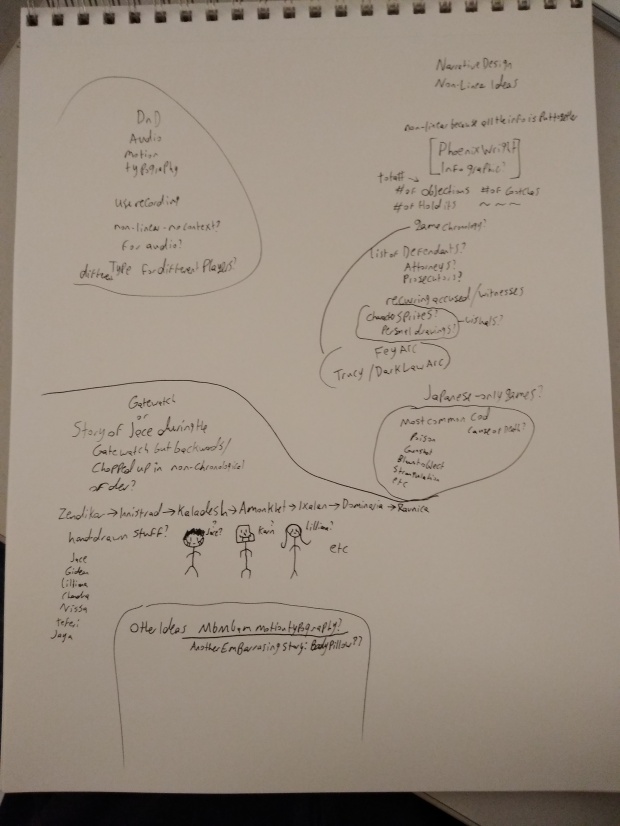
Project 3
QCQ, Group Project Outlines
QCQ: “Where Stones Can Speak…”
“a theory that shifts emphasis from the classic character-centered narrative viewpoint to a first-person experiential one.”
Based on the reading, the ability to experience an event or series of events by witnessing stories told in certain areas is just as important on grasping a narrative as watching a character go through their own story.
Is it possible for a narrative to have both character and environmental narrative to be able for viewers to gain more depth in the story?
Project 3 Outline, Design Brief, and Sketches
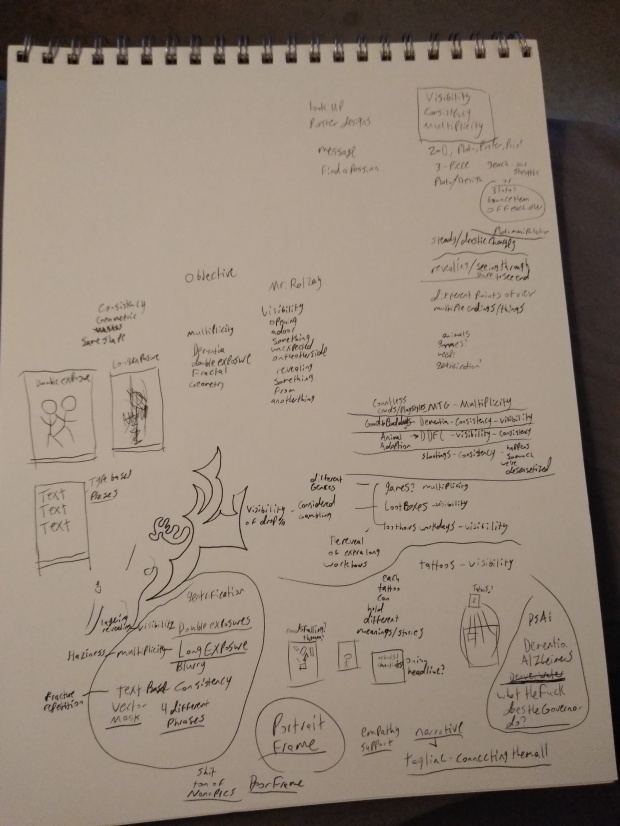
Above are some lists and sketches for the group project. I started out by listing different ideas that could be story driven, or go well with some of the memos. Darius and I then agreed on dementia, and we then moved on to how we would design three posters to show some of the effects of the disease.
Design Brief:
- Title
The Effects of Dementia (working title)
- Stakeholders
Team members: Darius Salomonson
Instructor: Carrie Osgood
Photos of: Bettie Van Zetten
- Context
Dementia is a mental disease that causes memory problems and loss, personality changes, and impaired reasoning. Dementia is often talked about with Alzheimer’s. My grandmother has had Dementia for a few years, so my family and I have witnessed firsthand the ups and downs she goes through with this disease.
- Problem identification
How can we show the effects of dementia while also giving it a narrative that’s clear and easy to understand?
- Objectives
The purpose of this project is to educate others about dementia and some of the effects.
- Audience
The preferred audience is everyone, because there are those that may not know what dementia looks like, while there are those that have witnessed it affect loved ones, so they may agree on what it looks like as Darius and I come up with the designs.
- Positioning and communication strategy
What single message should be communicated? These are some effects of dementia
What emotions should this message evoke? Possibly sympathy or empathy
What is the final call to action? Learn more about dementia or understand the signs
- Pragmatic issues
What issues must be overcome? We need to showcase the effects of dementia while also having a clear narrative for viewers to not get confused at what they’re looking at.
What noise can you foresee? Figuring out a phrase or title for the series that can be put on the posters to make the narrative easy to understand.
Who is your competition? N/A
What has been done in the past to attempt to solve this problem? Dementia is a mental disease that has no cure as of now, but there are plenty of organizations working on finding a cure.
- Project proposal summary
For this project, Darius and I plan on blending photography and photo manipulation as well as typography to create a series of posters showing different effects of dementia, while using three of the six memos as baselines: Visibility, Consistency, and Multiplicity. Each poster represents one of the three memos, using a different style of photo manipulation or typography, connecting them to dementia. The manipulation will be of photographs that have been taken of my grandmother, who is currently diagnosed with dementia.
Exercise 8: Infographics

Nowadays, video games with multiplayer aspects have been implementing ways to look at your personal statistics, so more competitive players can show off how skilled they are in-game. Overwatch is no exception, with easy access to stat pages so other players can see your numbers.
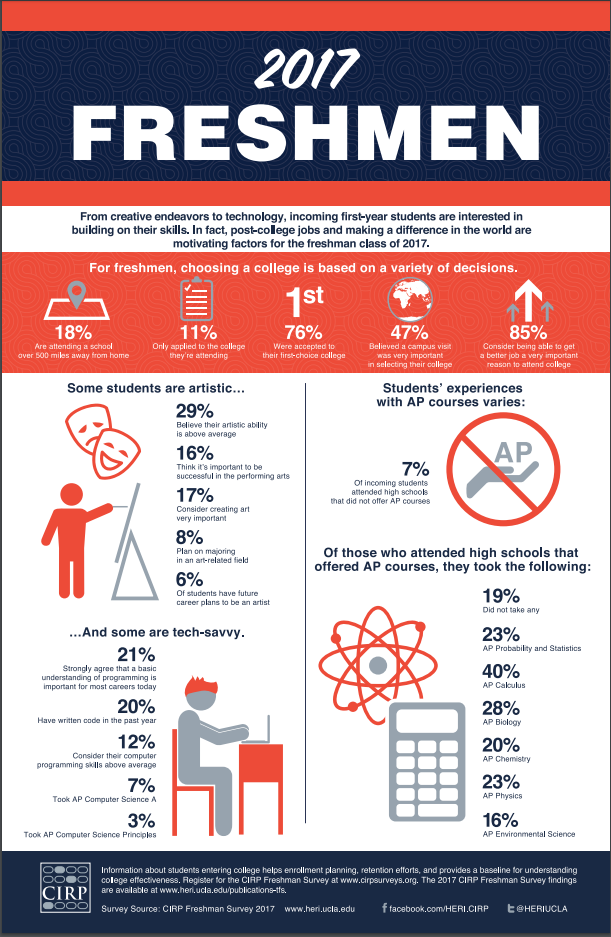
Like other examples shown Monday, this infographic shows a bunch of numbers that don’t really mean anything. The biggest problem is when reading this, I couldn’t find specific numbers. How many students were interviewed? How many of these students were asked less questions than others? These percentages are vague and don’t reveal the pool of people asked.
Project 2: Personal Narrative
Project 2 Final Draft
QCQ “Multiplicity”
“The modern books that we love most are the outcome of a confluence and a clash of a multiplicity of interpretive methods, modes of thought, and styles of expression.”
The things we love have been born out of countless different things, like ideas, objects, or stories.
If these things we love have come from multiple sources, can we call them original? Or is it because these things took different bits and pieces and made something new, that they are original in a newer sense?
QCQ “Visibility”
“We may distinguish between two types of imaginative process: the one that starts with the word and arrives at the visual image, and the one that starts with visual image and arrives at its verbal expression.”
The ability to visualize something through text or verbal expression is important when sharing information, or trying to create a world that others can visualize.
Is it possible to read something or to verbally express something that can’t be visualized? I’m talking in terms of trying to describe something that can’t normally be easily described.
QCQ “Exactitude” and Response to “The Wilderness Downtown”
Exactitude QCQ
“These are images stripped of the inner inevitability that ought to mark every image as form and as meaning, as a claim on the attention and as a source of possible meaning.”
This reminds me of something I read in my Art Theory and Criticism class, by Walter Benjamin. Overall, he discusses whether or not a replication of something has a “soul,” or a uniqueness in space and time.
Do images and language lose their “soul”? When something is so diluted or overexposed does it lose the uniqueness it once had, or could it grow a new uniqueness from that level of exposure?
The Wilderness Downtown
To put it bluntly, holy crap. Using such a personal thing like one’s address and then seeing it used with a music video really crafts a one-of-a-kind experience. I can definitely see why we were asked to view this in private, to become even more intimate. It was kind of scary, because a new neighbor moved in next door a couple of weeks ago so the street view I saw was incredibly recent. The only downsides is that it wasn’t focusing specifically on the place I live in, because the family stays in a condo neighborhood so it would only share the general street area, and the screens stopped working after the postcard portion, so I was left out, and any interest I had was lost.
QCQs and Exercise 7: Interactive Narrative
Interactive Narrative:
God of War (2018)

A soft reboot to the original PS2 game series, God of War focuses on an older Kratos and his son Atreus as they climb a mountain to fulfill the final wish of Atreus’ late mother. Along the way, countless conflicts arise, between Kratos and Nordic enemies, and between a father and son trying to connect after the loss of a loved one. The game follows Nordic folklore, and by spending time exploring this new world, you begin to learn its history.
Undertale (2015)
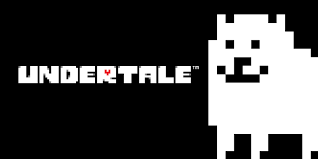
This RPG game had simplistic design and gameplay, but its narrative was driven by the moral dilemma of killing versus sparing. Undertale was considered the first RPG in which you can play the entire game not killing a single creature or boss. Depending on how you play, whether through violent or pacifist means, the writing of the game changes. There are even changes in writing if you go through multiple playthroughs and play differently each time.
The Walking Dead (and other TellTale Games)

Despite the fact that TellTale recently messed up with their company, their games are considered some of the greatest story-driven games to date (although personally that’s debatable). Each game is cut up into episodic sections, which were released one episode at a time, and where the choices you make in one episode alters how the story goes through the next episodes. TellTale has worked with other narratives such as Borderlands, Game of Thrones, Back to the Future, and Minecraft
Project 2 Design Brief
1 Title
The Pee Incident: The Day a Dog Peed Upwards at Me (probably not using a title)
2 Stakeholders
Instructor: Carrie Osgood
Others: May Family (close friends that will hopefully let me borrow their hose)
3 Context
On that day, I was going to a friend’s engagement party, so I had to deal with the essence of pee on my face for a couple hours, then run home to get a better clean, and then to the party.
4 Problem Identification
How can I depict a dog peeing on my face without having another dog actually pee on my face?
How can I tell this story in a way that will still have impact even though the area it happened to me is under construction, or now that the dog is no longer at the shelter?
5 Objectives
For this project I want to tell a funny story, to make viewers laugh at how it happened
6 Audience
The audience will be the class I show this to
7 Positioning and Communication Strategy
Altogether, I want this to be funny in a sort of grim way. I got peed on, so there’s some dark humor there because nobody enjoys getting peed on, but the story is funny.
8 Pragmatic Issues
One issue might be finding a photo of the dog/culprit on my computer
9 Project Proposal Summary
For this project I want to tell the story and use imagery like photos of the dog (if I can find it) and photos of where it happened or example videos, like using a hose to visualize the action of peeing as well as using narrative audio.
Intellectual Property Development QCQ
“As collaborative efforts, game settings raise questions of authorship familiar to students of film study”
The ability to have multiple people help each other make a well-built story and setting is more prevalent than ever, but the fact that it’s difficult to know which writer did what portion of a story as a consumer, not to mention that a secondary writer might not be as well credited might be a problem.
Is it possible, or a good idea to have fans help expand your game’s setting and story? For example, at this year’s E3, Ubisoft announced their upcoming game Beyond Good and Evil 2 will team up with Joseph Gordon-Levitt and his collaborative production company, HitRecord. Joseph announced that fans can go to a web page to share images, music, and more to collaborate with the team making the game to flesh out the setting.
Multicampaign Setting Design QCQ
“Along the same axis, gamers will often play several campaigns in the same setting, so for them the setting should ideally have sufficient depth that the same game group can retain interest in it.”
For players to enjoy any game nowadays, it has to have enough depth to allow players to dive deep into the universe or world so they don’t get bored.
Is it possible to have too much depth in a game? Even if hardcore fans of a game won’t get bored, will too much in a universe actually deter new players from trying, possibly scared of having too much to try to digest?
The GM and Role-Playing Campaigns QCQ
“All the GM really knows is the general ‘stops’ along the way – the destinations – but not necessarily how they will get there.”
A good level of improvisation is important when as a Game/Dungeon Master. However, improv is also a player’s greatest asset as well.
Would a game session be considered good or bad if the players manage to throw the DM’s plans, resulting with resounding swearing as the DM scrambles to bring the players back to their original line of plot?
Production of Space in Final Fantasy Games QCQ
“When these calculations are performed on a computer, players no longer directly perform this representational practice. Instead, the representation of space is constrained by technological considerations, and the perceptions of space becomes a matter worked out through the computer interface.”
It seems like by using a computer to create a space, it loses any sort of possible representation the DM of a tabletop game would give the world they create.
Does a world created by computers lose any sort of representation that could be a part of it? In Final Fantasy X, the area Zanarkand is an emotionally charged area, filled with trauma that is told in the story. However, in X-2 it’s turned into a tourist attraction, effectively changing the emotions in that area. Do these games lose that emotional representation simply because it’s made by a computer?
Exercise 6: Branding
Sony Corporations

In 1946, Masaru Ibuka and Aiko Morita founded Tokyo Tsushin Kogyo, or Tokyo Telecommunications Engineering Corporation, which is now known today as Sony Corporations. When his company was starting, Ibuka-san drew up the Founding Prospectus, an article considered to be Sony’s beginnings. In it, he writes the purpose of the corporation, which includes these two quotes among others:
“To establish of an ideal factory that stresses a spirit of freedom and open-mindedness, and where engineers with sincere motivation can exercise their technological skills to the highest level”
“To rapidly commercialize superior technological findings in universities and research institutions that are worthy of application in common households”
Sony has four main operating components: Electronics, motion pictures, music, and financial services.
Slogans:
The One and Only (1979-1982)
It’s a Sony (1982-2006)
like.no.other (2006-2009)
make.believe (2009-2014)
Be Moved (2014-present)
Logos
Sources: Tokyo Tsushin Kogyo Logo (Sony Time Capsule Vol. 3)
Sony Logo Timeline (Meaning and History of Sony’s Logo)
Electronics, motion pictures, and music:
Sony Entertainment Pictures is a large production company for a wide genre of movies and TV shows like Preacher, Jumanji: Welcome to the Jungle, and Breaking Bad.
Sony Music houses multiple record labels to help their artists produce large amounds of albums to sell. Some artists include Childish Gambino, N’Sync, and Meghan Trainer.
In terms of their electronics, Sony casts a wide net of what they develop and sell. At this year’s Consumer Electronics Show, Sony unveiled thinner, larger, and more vibrant televisions, music listening devices like wireless earbuds and speakers, a Go-Pro-like camera, and even AI technology with the Aibo robotic dog.
Sony is also famous for their series of Playstations. While the Playstation is a device made to play games, Sony also created ways to use it as a media player, so you can enjoy different types of media, so if you don’t like to play games, you can still use a Playstation.
Altogether, I believe that Sony has been a consistent company, developing and researching the future of electronics, just like Ibuka-san described in his Founding Prospectus. Even if all one sees is another television, more ear buds, another smart phone, and stuff like that, Sony is still pushing the boundaries of technology today. They’re even working on AI systems with what looks like a toy robot dog on the surface!
Sources:
Sony.net – Sony Global Website
Sony.com – Sony USA
Tech Explore 3, QCQs, and Exercise 5 (Logos and Advertisements)
Exercise 5: Logos and Advertisements
Local Business Logo: Denver Dumb Friends League
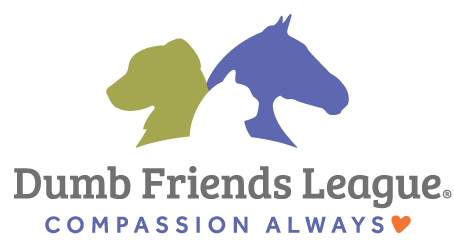
The Dumb Friends League has always been about taking care of animals, and only recently the logo was changed to incorporate horses because we recently acquired an area to take care of horses. I think the use of negative space for the cat silhouette is clever so all animals are present in our buildings in Denver and Castle Rock.
Local Business Advertisement: Chewy’s Bonetique

Unfortunately I couldn’t find any advertisements online for Chewy’s, but they are popular enough in the Denver Area to stay afloat, and they even recently expanded their floor space.
QCQs
“Truth Universally Adknowledged…”
“Batman managed to incorporate a successful series of comics, a series of films, and an animated television series. These were effectively the stories of three separate individuals, in separate fictional universes, for separate audiences, made by separate production teams.”
The fact that a series can be branched into multiple mediums and still hold it’s own is impressive, but there’s risk to go with it.
Do you think the severe medium branching for a series (making movies, comics, TV series using the same franchise), while a good idea so different audiences can become involved with that series, will inevitably backfire? For example, Spider-Man fans have become more critical towards movies after the three different tries using different actors, or how Marvel and DC constantly try to reboot series’ that have ended in order to get more money from fans. Does it also negatively impact a franchise that uses multiple mediums in an attempt to weave one large story if some fans don’t have access to some of those mediums?
QCQ “In What Universe?”
“Little did I realize at the time how complex the Star Wars Universe had become in the years since the release of the original films.”
In an attempt to write for the Star Wars franchise, it’s apparent how detailed the universe is, and how strict the rules are that come with it.
When it comes to a long running series like Star Wars, was it good or bad that George Lucas held such a tight leash on the universe that it heavily restricted some possible ideas, or even rejected some ideas altogether?
Project 2 Proposals
For this project I came up with three possible ideas
The first is a story about how a dog urinated upwards at my face on accident so I spent a long amount of time trying to wash it off to then immediately head to a friend’s engagement party. I figured this story would be funny because of how the dog managed to pee upwards at me.
Another idea I have is a time in high school when I made a video for a class that surprised everyone. It was a videography class, and the assignment was to parody a show to use it to teach science. This story was interesting because the surprise in the video was apparently something nobody expected out of me.
The final idea is asking my mom about the stories behind the tattoos she has. She has quite a few so for the sake of making a video short enough to upload I would focus on one or two. For this video I could take footage of her tattoos and possibly interview her about them, similar to documentary-style.
Project 1 and Advertisement Exercise
Good Ad
Bad Ad
The Sakeru Gum series is one of my favorite ad campaigns because each ad tells a part of a story, with a twist ending. Nowadays tv ads are just the same ones constantly for long periods of time, only to have new ads released that are then repeated in the same way. I think to really draw someone in you need more variety or else viewers will get tired of what you’re trying to sell.
For the bad advertisement, it’s supposed to be a board game of some kind, but the fact that you try to grab a piece of poo out of the air doesn’t seem appealing to me. These companies that try to push out ridiculous toys for kids to buy seem less and less fun, and the ads do the same as well.
QCQ “Quickness” and Project 1 Draft
“I would say that the moment an object appears in a narrative, it is charged with a special force and becomes like the pole of a magnetic field, a knot in the network of invisible relationships. The symbolism of an object may be more or less explicit, but it is always there.”
I think the concept of a magical object, like the ring in Lord of the Rings already has major narrative implications because it’s more than just an object, but the ability to create a creative story around a seemingly less important object is more of a challenge with a possibly greater reward.
Are there any stories that you know that have a seemingly normal object being used as a major narrative point?
Exercise 3 (Title Sequence)
For this exercise I chose the X-Files intro. The music is instantly recognizable and even though the series started in 1993 it’s still visually appealing, with a sense of eerie that carries through to the show itself.
Tech Explore 2
Project 1 Proposal
For the first project I plan on using the children’s book “The Very Hungry Caterpillar.” My vision includes creating all the necessary images by hand as well as either using text or a voice-over to tell the story. The story itself is fairly simplistic so I want to challenge myself by using multiple keyframes across multiple images on the screen in a horizontal fashion.
Exercise 2: Judging a Book by its Cover
Cover 1: Saw 5

The Saw 5 DVD case is interesting due to the intentional blurring of the character’s face. The typography for the movie title has kept it’s unnatural font for the first 7 movies so you know that it’s a horror movie from the font alone. The most interesting part about this cover is the fact that both this slip case as well as the dvd box are both transparent and the movie disc has a bright blue cover, so when everything lines up it appears as though the box is filled with water.
Cover 2: Thor Ragnarok
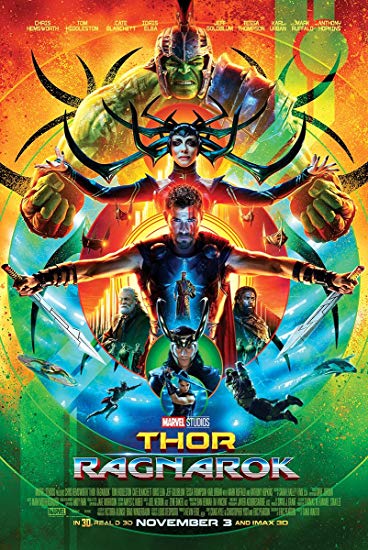
Unlike the countless other Marvel movies that are all darker, Thor Ragnarok changed how the series can be viewed with bright vibrant colors, and a 70s metallic vibe for the title typography.
Cover 3: Animal Crossing: New Leaf

The Animal Crossing series has always focused on a relaxing game style that lets players take their time and have fun. For the New Leaf cover, the imagery focuses on some new aspects of the game when it first came out on the 3DS. The typography has the title on a neighborhood posting board, and the subtitle New Leaf is an homage to the series jumping onto a new console as well as doing new things for the series.
Cover 4: Yakuza Kiwami

The Yakuza game series has always focused on the Japanese mafia underbelly in the Kamurocho district between the 1980s to present day. Because of this, Sega wanted the covers to follow that Yakuza style. It is known that high ranking Yakuza members get giant back tattoos, which is represented by the large koi fish and dragon in the background, and the thick uneven brush strokes used for the typography reflects Japanese calligraphy. The cover also has the protagonist and antagonist on it to show who you are and who you will come up against.
Bad Cover: The Room
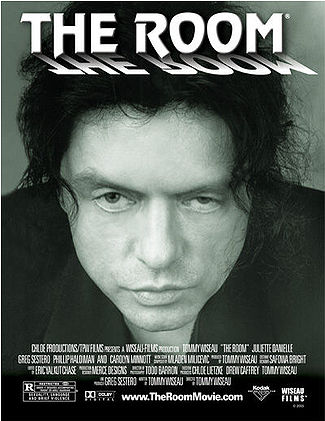
Despite the fact that I enjoy watching The Room, the cover for it is bad and doesn’t show anyone what the movie is about. The title is especially hard to look at because it looks half-done.
Exercise 1 (Imagery)
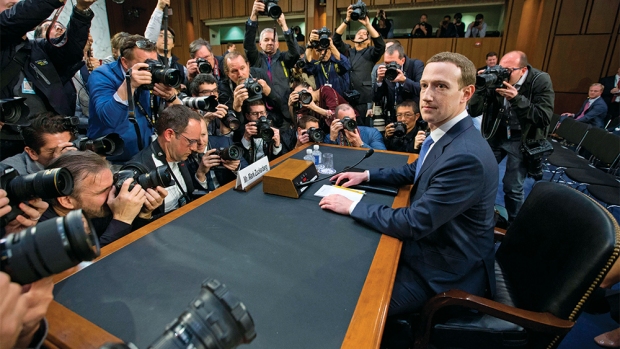
Credit: Photo taken by Michael Reynolds for the article “Facebook’s Congressional Hearing Won’t Bury Mark Zuckerberg’s Empire“
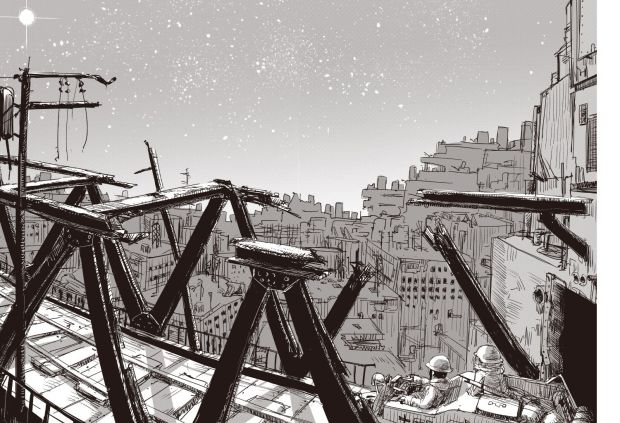
For the illustration I chose a 2-page spread from the manga “Girls Last Tour,” written and illustrated by Tsukumizu. It’s a story about two girls that explore a post-apocalyptic world. Tsukumizu’s art shines through when it comes to revealing large areas of this destroyed world.
Credits: Image 1 (the four bottles) shared to Time Magazine by flintwaterstudy.org for the article “Flint’s Water Crisis in 3 GIFs”
Image 2 (piles of water bottles) used in the article “Republicans in Congress Close Yearlong Flint Water Crisis Inquiry With no New Findings” by Claire Lampen of Mic.com
Image 3 (wall with time painted on) photo taken by Andrew Moore for the article “The ‘Flint Rock’ Now a Reminder of the Flint Water Crisis“
Image 4 (children standing around piles of water bottles) used for the article “Flint Water Crisis: What’s Being Done to Help Children Exposed to Lead” by ABC News
Credits
Image 1: Image taken by Laura Heald for CBS article “Multiple Dead in Mass Shooting at Gaming Tournament in Jacksonville, Florida“
Image 2: Image taken by Joe Raedle for USA Today article “Remembering the Pulse Nightclub Shooting“
Image 3: Image taken by Armando L Sanchez for USA Today article “At Least 72 Shot, 11 Killed in Chicago Over Violent Summer Weekend“
Image 4: Image taken by Ed Murray for NJ.com article “Art All Night Shooting in Trenton“
Readings and QCQs #1
“Alice & Dorothy Play Together”
“You no longer had to find your own way; you chose which track to run on, and then set out to follow it. Newbies in particular like this Dorthy way of doing things.”
When I read about how tabletop games in the late 90s and early 2000s were this simplified, it’s kind of jarring. Nowadays tabletop games like D&D or Pathfinder, and even modern video games have been focusing on the opposite of placing a player on a set track. Games today give players options to do, while still giving you an end game. There are still some games that focus on a track and not a sandbox that sell very well, however.
In terms of the Hero’s Journey, is it possible for a sandbox game to have the compelling story that a singular track can have? Is it possible for a track game to have the openness and collectivity a sandbox game has? Is it possible to have a game that can balance everything out as evenly as possible, or is it difficult or impossible to have a perfect blend?
“Textbook Intro”
“Henry Lowood’s chapter considers how World of Warcraft’s space and software is used to produce “machinima” that tells stories of a traditional linear form – but that are frequently told as responses to the non-linear virtual world”
One of the ways Blizzard is so popular is because the games they make are full of stories that players can jump in and piece together through playing, animated shorts, and continuous expansions.
One of Blizzard’s more recent games, Overwatch follows this type of story telling, but many people believe that giving us a character and having us figure out who they are, only for Blizzard to create a short that shows us a new, different side to those characters, is a bad idea. Is it possible to do something like this without having it backfire?
Portfolio





